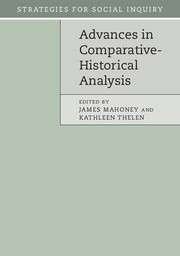Book contents
- Frontmatter
- Contents
- List of figures
- List of tables
- List of contributors
- Preface
- Part I Introduction
- Part II Agenda-setting work
- Part III Tools for temporal analysis
- 5 Power and path dependence
- 6 Critical junctures and institutional change
- 7 Drift and conversion: hidden faces of institutional change
- Part IV Issues of method
- Epilogue: comparative-historical analysis: past, present, future
- Index
- References
7 - Drift and conversion: hidden faces of institutional change
from Part III - Tools for temporal analysis
Published online by Cambridge University Press: 05 July 2015
- Frontmatter
- Contents
- List of figures
- List of tables
- List of contributors
- Preface
- Part I Introduction
- Part II Agenda-setting work
- Part III Tools for temporal analysis
- 5 Power and path dependence
- 6 Critical junctures and institutional change
- 7 Drift and conversion: hidden faces of institutional change
- Part IV Issues of method
- Epilogue: comparative-historical analysis: past, present, future
- Index
- References
Summary
Until recently, institutionally minded scholars in the social sciences generally treated institutions as fixed. Whether defined as the rules of the political game, the standard operating procedures of bureaucracies, or the regularized norms guiding organizational behavior, institutions were associated with stability and were invoked as independent or intervening variables to explain persistent cross-national differences in outcomes. More recent work in the field, however, has attempted to provide greater insight into how institutions evolve and how institutional effects can change over time. Instead of seeing institutions as largely unchanging features of the political environment, these arguments seek to specify what kinds of institutional changes propelled by what kinds of social processes are most likely under what kinds of political configurations.
This chapter advances this more recent agenda, examining two important, common, and theoretically explicable processes through which institutional effects change over time, which we call “drift” and “conversion.” Drift occurs when institutions or policies are deliberately held in place while their context shifts in ways that alter their effects. A simple example is the US minimum wage, which is not indexed to inflation and thus declines in value as prices rise unless new federal legislation is enacted. Those wishing to effect change through drift need only prevent the updating of existing rules. Drift thus depends on how sensitive the effects of an institution are to its context, whether policies are designed in ways that foster updating in the face of changing circumstances, and whether it is easy or difficult to block such updating.
Conversion, by contrast, occurs when political actors are able to redirect institutions or policies toward purposes beyond their original intent. An example is the ability of corporations to use the Sherman Antitrust Act of 1890 to hinder labor unions. Passed amid widespread concern about corporate collusion, the legislation was meant to break up business trusts that were “in restraint of trade.” Yet corporations managed to convince federal courts that union organizing was “in restraint of trade.”
- Type
- Chapter
- Information
- Advances in Comparative-Historical Analysis , pp. 180 - 208Publisher: Cambridge University PressPrint publication year: 2015
References
- 122
- Cited by



